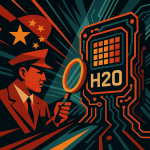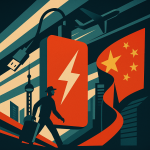Key Points
- China is actively exploring Small Modular Reactors (SMRs) to power energy-intensive data centers, leveraging SMRs for domestic clean energy.
- SMR development is a global trend driven by massive AI power demands, climate goals, and tech giants seeking clean energy solutions (like Google’s PPA with Kairos Power).
- China has made significant progress, with projects like “Linglong One” (玲龙一号) under construction (expected completion 2026) and the HTR-PM (200 MWe) in commercial operation since late 2023.
- China sees unique applications for SMRs beyond large-scale grid power, including urban heating, industrial steam, island & marine power, and potentially replacing coal units.
- While initial per-kilowatt construction costs are higher than large reactors, the Levelized Cost of Energy (LCOE) is competitive with natural gas, with future costs expected to decrease with mass production.
China is exploring the use of small nuclear reactors (SMRs) to power the energy-hungry data centers fueling the AI revolution, marking a significant step in domestic clean energy development.


Find Top Talent on China's Leading Networks
- Post Across China's Job Sites from $299 / role
- Qualified Applicant Bundles
- One Central Candidate Hub
Your First Job Post Use Checkout Code 'Fresh20'

The Global Surge: Why SMRs Are Suddenly Hot
The buzz around small modular reactors isn’t just happening in China; it’s a global phenomenon.
What’s driving it?
- Massive AI Power Demands: Artificial intelligence requires staggering amounts of electricity, pushing tech companies to find reliable, powerful energy sources.
- Climate Change Goals: Nations worldwide are pushing for decarbonization, making nuclear energy, especially flexible SMRs, an attractive option.
- Tech Giants Need Clean Power: Big tech firms face pressure to reduce their carbon footprint, leading them to invest directly or make power purchase agreements (PPAs) for clean energy.
We’re already seeing major moves:
- Last October, Google announced a PPA with Kairos Power.
- Kairos Power aims to deploy seven SMRs around 2030 specifically for Google’s needs.
Investor sentiment reflects this trend.
Throughout 2024, US nuclear power stocks have seen impressive gains:
- NANO Nuclear Energy: Stock price surged nearly 650% since its May listing.
- NuScale Power: SMR supplier saw its stock jump almost 950% at one point.
- Vistra Energy: Power giant’s stock price climbed over 320% at its peak.
- Oklo Inc. & Constellation Energy Corporation: Both saw stock prices double.
US Nuclear-Related Stock Performance Highlights (2024)
Source: Data derived from article text. Gains reflect peak performance noted in the article during 2024.

ExpatInvest China
Grow Your RMB in China:
- Invest Your RMB Locally
- Buy & Sell Online in CN¥
- No Lock-In Periods
- English Service & Data
- Start with Only ¥1,000

Defining the Tech: SMRs vs. Micro-Reactors
Let’s clarify the terms, based on the International Atomic Energy Agency (IAEA) guidelines:
- Small Modular Reactors (SMRs): Electrical power output below 300 MWe.
- Micro-Reactors: Electrical power output usually not exceeding 15 MWe.
IAEA Reactor Size Definitions
Source: International Atomic Energy Agency (IAEA) guidelines mentioned in the article.

Resume Captain
Your AI Career Toolkit:
- AI Resume Optimization
- Custom Cover Letters
- LinkedIn Profile Boost
- Interview Question Prep
- Salary Negotiation Agent

Who Else is Racing Ahead? International SMR Development
Wang Binghua (王炳华), Specially Invited Advisor to the Expert Committee of the China Nuclear Energy Association (Zhongguo Heneng Hangye Xiehui 中国核能行业协会) and former Chairman of the State Power Investment Corporation Limited (SPIC, Guojia Dianli Touzi Jituan Youxian Gongsi 国家电力投资集团有限公司), highlighted that SMRs are a major R&D focus for nuclear leaders like the US, Russia, and France.
Key international developments include:
- United States: The Department of Energy restarted a $900 million USD funding program in March 2024, targeting commercial deployment of modular small light-water reactors. Tech giants like Google, Oracle (Jia gu wen 甲骨文), and Amazon (Yama xun 亚马逊) are investing in SMRs for carbon-free data center power.
- European Union: The European Commission launched an SMR industry alliance in February 2024 to fast-track development and deploy the first SMRs by the early 2030s.
- Russia: Signed its first onshore SMR export deal with Uzbekistan and is actively promoting its floating nuclear power plant technology globally.
Globally, the IAEA tracks over 80 SMR designs.
Most are based on Generation III tech, with some Gen IV concepts.
The main tech categories are:
- Water-cooled (Land & Sea): Primarily Pressurized Water Reactors (PWRs) – 43.1%
- Gas-cooled: 19.4%
- Fast Neutron: 15.3% (70% of these are lead-cooled)
- Molten Salt: 13.9%
- Others: 8.3%
Global SMR Design Technology Distribution
Source: Data based on IAEA tracking mentioned in the article.
Crucially, about 70% of near-term deployable SMR tech uses integrated, advanced PWR designs.

Caption: Installation work underway on the “Linglong One” small reactor.

China’s SMR Edge: Leading the Deployment Race
“China has made significant achievements in the development of small reactor technology and leads in the deployment of onshore small pressurized water reactors,” stated Wang Binghua.
Six major players are driving China’s SMR innovation:
- China National Nuclear Corporation (CNNC, Zhonghe Jituan 中核集团)
- China General Nuclear Power Group (CGN, Zhongguanghe 中广核)
- State Power Investment Corporation Limited (SPIC, Guojia Dianli Touzi Jituan Youxian Gongsi 国家电力投资集团有限公司)
- Chinese Academy of Sciences (CAS, Zhongkeyuan 中科院)
- Tsinghua University (Qinghua Daxue 清华大学)
- China Shipbuilding Industry Corporation (CSIC, Zhongchuan Zhonggong 中船重工)
Together, they’ve developed 12 types of small reactor technologies across various types and applications, including:
- Land-based water reactors
- Marine water reactors
- High-temperature gas-cooled reactors
- Fast reactors
- Molten salt reactors

Caption: On April 16th, 2024, the main pump for the world’s first “Linglong One” (Linglong Yihao 玲龙一号) small reactor was successfully hoisted into place, marking a critical phase for system installation.
Key Chinese SMR project milestones:
- Linglong One (ACP100): Developed by CNNC, currently under construction. Expected completion in 2026, potentially becoming the world’s first onshore commercial modular SMR.
- HTR-PM (200 MWe): High-temperature gas-cooled reactor developed by Tsinghua University. Began commercial operation in late 2023.
- Thorium Molten Salt Reactor (2 MWt): Developed by CAS. Achieved full power operation in 2024.
- Heating Reactors: Projects like SPIC’s integrated heating reactor, the NHR200-Ⅱ (CGN & Tsinghua), and CNNC’s Yanlong (Yanlong 燕龙) DHR-400 pool-type reactor are actively progressing.
- Marine Reactors: CGN and CNNC have developed floating reactor models like ACPR50S, ACP100S, and ACP25S.
Key Chinese SMR Project Milestones
Source: Data derived from article text. MWe = Megawatts electric, MWt = Megawatts thermal.

Finding the Fit: Unique SMR Applications in China
While China has extensive grid coverage, making SMRs less competitive purely for large-scale power generation compared to giant nuclear plants, they excel in specific niches.
Wang Binghua identifies key target markets:
- Replacing Coal Cogeneration Units: Swapping out small/medium coal plants.
- Regional Heating: Providing clean heat for northern cities.
- Industrial Steam: Supplying petrochemical plants via “nuclear-petrochemical coupling.”
- Marine & Island Power: Supporting development in remote areas.
- Special Users: Like data centers needing dedicated, reliable, clean power.
- Exports: Catering to countries needing smaller-scale energy solutions.
Let’s dig into some specifics:
- Coal Plant Conversion: A US DOE report explored converting retired coal plants to nuclear. China faces a peak retirement wave for coal units around 2030. Companies like China Huaneng Group (Huaneng Jituan 华能集团), SPIC, CGN, and China Energy Investment Corporation (China Energy, Guojia Nengyuan Jituan 国家能源集团) are already studying building SMRs on former thermal plant sites.
- Urban Heating: Northern Chinese cities have over 18 billion sq meters of heating area, mostly (>80%) fossil-fueled. By 2060, an estimated 11 billion sq meters will need transitioning. China’s low-temperature heating reactors (like pool-type designs) are purpose-built for this large-scale clean heating need.
- Industrial Decarbonization: Nuclear-generated steam offers a path for the petrochemical industry’s green transformation.
- Island & Marine Development: Floating or island-based SMRs are seen as critical strategic options for China’s island development plans, providing essential energy infrastructure. Efforts are underway to match market needs with the right SMR tech.

Looking Abroad: SMR Export Potential & Cost Factors
The export market holds significant promise, especially along the Belt and Road Initiative (Yidai Yilu 一带一路).
“Considering that most countries participating in the Belt and Road Initiative… have relatively small land areas and moderate populations, large nuclear power plants may not be suitable,” Wang Binghua noted.
SMRs offer adaptability to smaller grid capacities and diverse regional energy needs (electricity, heating).
The strategy proposed includes:
- Using SMRs as a key tool in China’s “going global” nuclear strategy.
- Targeting Belt and Road nations interested in nuclear but lacking grids for large plants.
- Conducting promotional activities via international diplomacy.
- Performing market assessments and technical surveys to tailor SMR models for these specific needs.
What about the cost?
Currently, the construction cost per kilowatt for SMRs is roughly double that of large commercial nuclear projects.
However, preliminary calculations suggest the levelized cost of energy (LCOE) for SMR electricity and heat is already competitive with natural gas.
Crucially, with mass production and large-scale deployment, SMR market competitiveness is expected to increase significantly in the future.
The development of small nuclear reactors signifies a major shift in energy strategy, particularly for power-intensive sectors like data centers, with China positioning itself at the forefront.

FAQs
What is a Small Modular Reactor (SMR)?
An SMR is a nuclear reactor generally producing less than 300 megawatts of electric power (MWe). They are designed to be factory-built (modular) and transported to a site for installation, potentially reducing construction time and costs compared to traditional large reactors.
Why use SMRs for data centers?
Data centers, especially those powering AI, require vast amounts of reliable, constant, and increasingly clean power. SMRs can provide dedicated, carbon-free electricity 24/7 directly on-site or nearby, offering potential advantages in energy security, grid independence, and meeting sustainability goals.
Is China the only country developing SMRs?
No, SMR development is a global effort. The US, Russia, France, the UK, Canada, South Korea, and others are actively researching, developing, and funding SMR projects. However, China is notable for having multiple projects under construction or in advanced stages, like the Linglong One.
Are SMRs safe?
Modern SMR designs incorporate advanced safety features, often relying on passive systems that use physics (like gravity or natural circulation) rather than active electrical or mechanical systems to shut down and cool the reactor in emergencies. They are subject to rigorous regulatory oversight, similar to large nuclear plants.
Are SMRs cheaper than large nuclear plants?
Currently, on a per-kilowatt basis, the *first-of-a-kind* SMR construction costs are generally higher than established large reactor designs. However, the goal is for costs to decrease significantly through mass manufacturing (factory production) and streamlined deployment. Their overall energy cost may already be competitive with fossil fuels like natural gas in certain applications.
References
- Original Source: The Paper (Pengpai Xinwen 澎湃新闻)
- Source Website: The Paper (Pengpai Xinwen 澎湃新闻)




